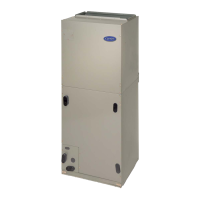PROPERTY DAMAGE HAZARD
Failure to follow this caution may result in product or
property damage.
If a disconnect switch is to be mounted on unit, select a
location where drill or fastener will not contact electrical or
refrigerant components.
Before proceeding with electrical connections, make certain that
supply voltage, frequency, phase, and ampacity are as specified on
the unit rating plate. See unit wiring label for proper field high-
and low-voltage wiring. Make all electrical connections in
accordance with the NEC and any local codes or ordinances that
may apply. Use copper wire only.
The unit must have a separate branch electric circuit with a
field-supplied disconnect switch located within sight from, and
readily accessible from, the unit.
On units with a factory-installed disconnect with pull-out
removed, service and maintenance can be safely performed on only
the load side of the control package.
ELECTRICALSHOCK HAZARD
Failure to follow this warning could result in personal iniury or
death.
Field wires on the line side of the disconnect found in the fan coil
unit remain live, even when the pull-out is removed. Service and
maintenance to inconfing wiring cannot be performed until the
main disconnect switch (remote to the unit) is turned off.
A. Line Voltage Connections
If unit will contain accessory electric heater, remove and discard
power plug from fan coil and connect male plug from heater to
female plug from unit wiring harness. (See Electric Heater
Installation Instructions.)
For units without electric heater:
1. Connect 208/230v power leads from field disconnect to yel-
low and black stripped leads.
2. Connect ground wire to unit ground lug.
NOTE: Units installed without electric heat should have a
field-supplied sheet metal block-off plate covering the heater
opening. This will reduce air leakage and formation of exterior
condensation.
B. 24-v Control System
Connection To Unit
Wire low voltage in accordance with wiring label on the blower.
(See Fig. 10 through 15.) Use no. 18 AWG color-coded, insulated
(35°C nfininmm) wire to make the low-voltage connections
between the thermostat, the unit, and the outdoor equipment. If the
thermostat is located more than 100-ft (30 m) from the unit (as
measured along the low-voltage wire), use no. 16 AWG
color-coded, insulated (35 °C nfininmm) wire. All wiring nmst be
NEC Class 1 and must be separated from inconfing power leads.
THERMOSTAT
[]
FAN COIL
(CONTROL}
RED R
_G
W2
W3
L_o E
A_R COND.
Fig. 10 - Wiring Layout Air Conditioning []nit
(Cooling Only)
TH ERMOSTAT
E]-
[Eb
FAN COIL
(CONTROL)
R
G
W2
W3
E
C
AIR COND.
Fig. 11 - Wiring Layout Air Conditioning []nit
(Cooling and 1-Stage Heat)
FAN COIL
THERMOSTAT (CONTROL)
EP
[]
[]
Eb m
-_Y G
W3
h / wo __
HEAT PUMP
(CONTROL)
R
C2x_ c
w2
o
y
Fig. 12 - Wiring Layout Heat Pump []nit
(Cooling and 2-Stage Heat with
No Outdoor Thermostat)
A94058
A94059
A94060

